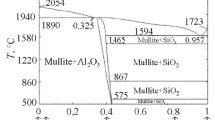The physical-chemical interactions at contact of molten glass with refractories in a glassmaking furnace, mostly electricity melted baddeleyite – corundum (bacor), are examined. Three basic interactions are discussed: surface phenomena, chemical interactions, and transport phenomena.
Similar content being viewed by others
References
O. N. Popov, Corrosion and Service of Refractory Materials in Tank Glassmaking Furnaces during High-Temperature Glassmaking [in Russian], VNIIÉSM, Moscow (1974).
O. N. Popov, “On the kinetics of the interaction of melt-cast refractories with commercial-glass melts,” in: Investigations in the Field of Refractories for Glassmaking Furnaces [in Russian], GIS, Moscow (1984), pp. 8 – 17.
S. Bach, F. Baukke, R. Bruekner, et al., Types of Rejects in Glass Production, edited by H. Jebsen-Marwedel and R. Brueckner [Russian translation], Stroiizdat, Moscow (1986).
N. I. Min’ko and V. M. Nartsev, “Effect of the glass composition on the corrosion of zirconium-containing refractories in a glassmaking furnace,” Steklo Keram., No. 10, 3 – 9 (2007); N. I. Minko and V. M. Nartsev, “Effect of the glass composition on corrosion of zirconium-containing refractories in a glassmaking furnace (a review),” Glass Ceram., 64(9 – 10), 335 – 342 (2007).
Yu. A. Guloyan, “Surface phenomena in the technology of glass,” Steklo Keram., No. 5, 10 – 18 (2006); Yu. A. Guloyan, “Surface phenomena in glass technology (a review),” Glass Ceram., 6(5 – 6), 146 – 153 (2006).
Yu. A. Guloyan, “Transport phenomena in glass technology,” Steklo Keram., No. 11, 7 – 16 (2007); Yu. A. Guloyan, “Transport phenomena in glass technology (Review),” Glass Ceram., 64(11 – 12), 382 – 390 (2007).
N. A. Toropov, V. P. Barzakovskii, V. V. Lapin, et al., Handbook of Phase Diagrams of Silicate Systems [in Russian], Nauka, Leningrad (1972), Vol. 3.
G. A. Rashin, E. P. Rashina, and N. N. Rokhlin, Diagnostics of Flaws in High-Quality and Container Glasses [in Russian], Legkaya industriya, Moscow (1980).
A. R. Cooper and W. D. Kingery, “Kinetics of solution in high viscosity liquids: sodium chloride – glycerol,” J. Phys. Chem., 66(10), 665 – 668 (1962).
R. Bruckner, “Die zu Erosion an Modellsubstanzen und fenerfesten Stoffen fuhrenden Grundmechanizmen der Grenzflachenkonvection,” Glastechnische Berichte, 40(12), 451 – 462 (1967).
J. Loffler, “Physikalische und chemische Reaktionen, die in Glaswannen zur Ausbildung von Spulfugen oder zum Lochfras fuhren,” Glastechnische Berichte, 38(10), 398 – 405 (1967); 40(10), 374 – 378 (1967).
T. S. Busby, “Simulative studies of upward-drilling,” J. Am. Ceram. Soc., 49(5), 441 – 446 (1966).
T. S. Busby, G. C. Cox, and B. E. Gillespie, “Upward-drilling: physicochemical aspects and the implication for furnace design,” Glass Technol., 121(4), 94 – 102 (1971).
V. G. Levich, Physical-Chemical Hydrodynamics [in Russian], Fizmatgiz, Moscow (1959).
D. A. Frank-Kamenetskii, Diffusion and Heat Transfer in Chemical Kinetics [in Russian], Nauka, Moscow (1987).
P. M. Shurygin and V. N. Boronenkov, “Kinetics of the interaction of magnesium, silicon, and aluminum oxides with the melts of the ternary system CaO, Al2O3, and SiO2,” Ogneupory, No. 12, 561 – 565 (1963).
Yu. A. Guloyan and O. M. Boronenkov, “Diffusion kinetics in the interaction of corundum refractories with molten glass,” Steklo Keram., No. 10, 33 – 37 (2006); Yu. A. Guloyan and O. M. Boronenkov, “Diffusion kinetics in the reaction of corundum refractories with a glass melt,” Glass Ceram., 3(9 – 10), 346 – 350 (2006).
E. N. Gramenitskii and A. M. Batanova, “Mechanisms of the interaction of refractories and glass-forming melts in the light of the theory of diffusion zonality,” Steklo Keram., No. 8, 9 – 13 (1996); E. N. Gramenitskii and A. M. Batanova, “Regular features of the interaction between refractories and glass-forming melts in the light of the theory of diffusion zones,” Glass Ceram., 3(7 – 8), 229 – 233 (1996).
V. D. Tokarev, S. S. Ignat’ev, and O. N. Popov, “Analysis of the service of refractory materials in tank glass-making furnaces,” Steklo Keram., No. 5, 19 – 22 (2006); V. D. Tokarev, S. S. Ignat’ev, and O. N. Popov, “Analysis of the service of refractory materials in glass-making tank furnaces,” Glass Ceram., 63(5 – 6), 154 – 157 (2006).
O. M. Pustyl’nikov and Yu. A. Guloyan, “Service and production conditions of electricity melted refractory articles,” Steklo Keram., No. 12, 13 – 17 (2009); O. M. Pustyl’nikov and Yu. A. Guloyan, “Service and production conditions of electromelted refractory articles,” Glass Ceram., 66(11 – 12), 412 – 416 (2009).
R. Nebel’, “Zirconium striae — level of knowledge and approaches to problem solving. Pt. 1 – 2,” Steklyannaya Tara, No. 1, 6 – 7 (2002); No. 2, 6 – 8 (2002).
Author information
Authors and Affiliations
Corresponding authors
Additional information
Translated from Steklo i Keramika, No. 10, pp. 3 – 9, October, 2010.
Rights and permissions
About this article
Cite this article
Guloyan, Y.A., Pustyl’nikov, O.M. Physical-chemical interactions during contact between molten glass and refractories. Glass Ceram 67, 297–303 (2011). https://doi.org/10.1007/s10717-011-9283-2
Published:
Issue Date:
DOI: https://doi.org/10.1007/s10717-011-9283-2




